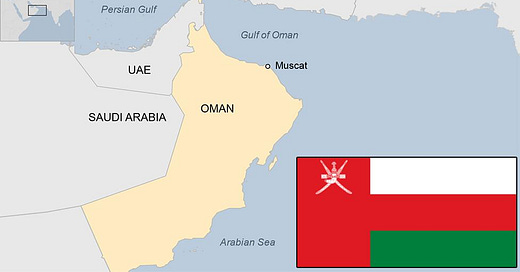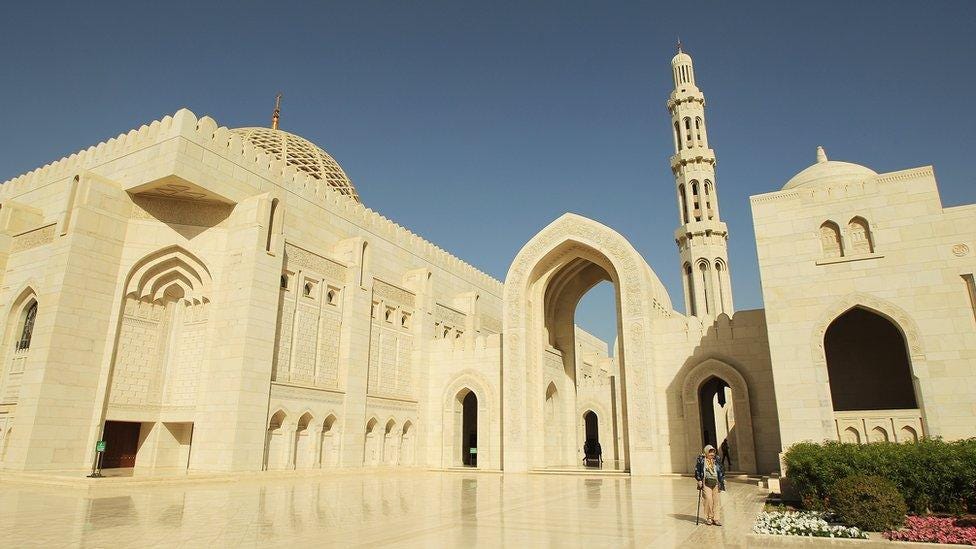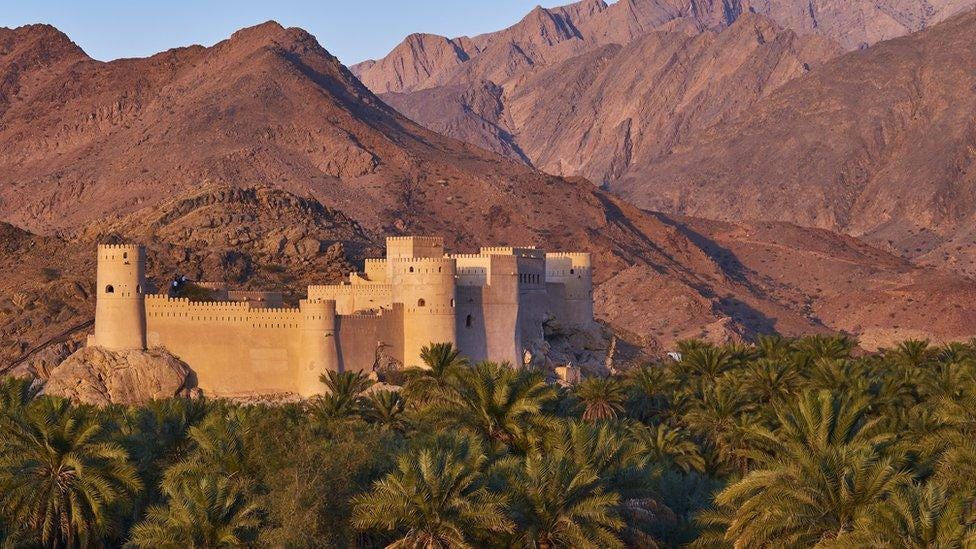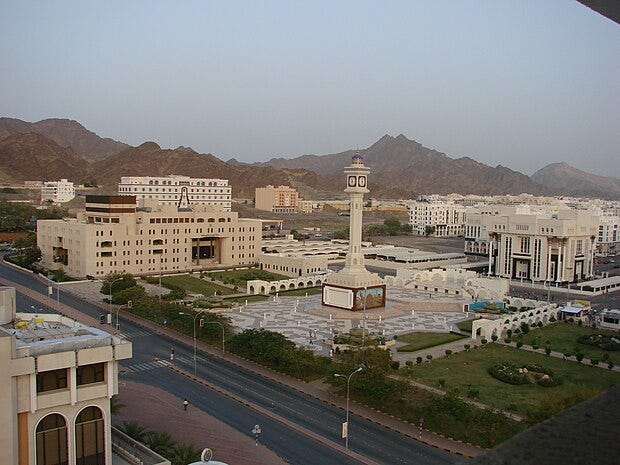Oman country profile
Oman is the oldest independent state in the Arab world. It is strategically placed at the mouth of the Gulf at the south-east corner of the Arabian Peninsula.
Oman is the oldest independent state in the Arab world. It is strategically placed at the mouth of the Gulf at the south-east corner of the Arabian Peninsula.
From the 17th Century onwards, the Omani Sultanate was an empire and competed with the Portuguese and British empires for influence in the Persian Gulf and Indian Ocean.
In the 19th Century, Oman's extended across the Strait of Hormuz to Iran and Pakistan and down the East African coast to Zanzibar.
After deposing his father in 1970, Sultan Qaboos opened up the country and embarked on a policy of modernisation - abolishing slavery which had once been a key part of its trade.
Oil reserves in Dhofar were discovered in 1964. The main threat to Oman's territorial integrity came with the 1965-75 Dhofar Rebellion, which saw pro-Soviet secessionist forces pitted against government troops. It was finally put down with military support from the UK, Iran, Jordan and Pakistan.
Oman has not been immune from the groundswell of political dissent in the region, however. Sultan Qaboos responded to the rare outbreak of discontent in 2011, following the wave of pro-democracy protests across the Arab world, by promising more jobs and benefits after initially suppressing demonstrations.
However, he also determined that the centre of political power, combining both executive and legislative powers, should remain his personal prerogative, closed off from any debate.
SULTANATE OF OMAN: FACTS
Capital: Muscat
Area: 309,500 sq km
Population: 4.5 million
Language: Arabic
Life expectancy: 76 years (men) 80 years (women)
LEADERS
Head of state: Haitham bin Tariq Al Said
Haitham bin Tariq Al Said succeeded to the throne on the death of his cousin, Qaboos Bin Said Al Said, in January 2020.
Sultan Haitham was 65 on his accession, and the Oxford-educated veteran government official is expected to continue both his predecessor's neutral path in foreign affairs and his focus on economic and social reform.
As head of Oman's Vision 2040 initiative, Sultan Haitham has been heavily involved in efforts to make the country less reliant on oil and gas exports for revenue - one of the country's main economic challenges.
Policies favouring Omanis in employment for the last 20 years have had limited results, with continuing social inequalities, unemployment and poverty.
MEDIA
Image caption,
The Sultan Qaboos mosque in Muscat, which was completed in 2000, is the largest mosque in Oman
The government operates the main broadcasters, and press freedom groups say that media censorship is widespread.
The internet is a medium for public debate, but online activists can be targeted by the authorities, says Reporters Without Borders.
TIMELINE
Image caption,
Nakhl fort in northern Oman dates from the 7th Century, but was extensively expanded and developed in the 18th and 19th Centuries
Some key dates in Oman's history:
8th Century - Onset of Arab domination and the introduction of Islam.
1507 - Portuguese sack Muscat and capture the Omani coast; they are driven out in 1650.
1737 - Persians invade and are driven out in 1749, when the Al Bu Said dynasty comes to power, which continues to rule to this day.
1800s-1900s - Omani empire expands to include Zanzibar and Mombasa on Africa's east coast and parts of the Indian subcontinent, reflecting Oman's strong maritime heritage.
1913 - Control of the country splits. The interior is ruled by Ibadite imams and the coastal areas by the sultan.
1920 - Under a British-brokered agreement, the sultan recognises the autonomy of the interior.
1954-59 - Jebel Akhdar War sees fighting between local Omanis in the interior, led by their elected imam, Ghalib al-Hinai, and forces of the sultan, backed by the UK and a consortium of global oil firms - a key factor being the oil reserves in the interior of Oman.
1959 - Helped by the British army and an RAF bombing campaign, Sultan Said bin Taimur regains control of the interior. His rule is characterised by a feudal and isolationist approach.
1964 - Oil reserves are discovered; production begins in 1967.
1965-75 - Dhofar Rebellion in southern Oman, sees leftist forces secessionist forces fighting government troops. The uprising is finally put down with considerable military backing from the UK, as well as Jordan, UAE and Iran.
1970 - The sultan is overthrown by his son in a bloodless coup. Sultan Qaboos bin Said begins a liberalisation and modernisation programme.
Image caption,
Sultan Qaboos undertook a policy of modernisation and economic reforms, with increased spending on health, education and welfare
1981 - Oman is a founding member of the six-nation Gulf Cooperation Council.
1997 - Sultan Qaboos decrees that women can stand for election to - and vote for - the Consultative Council. Two women are duly elected.
1999 - Oman and neighbouring United Arab Emirates (UAE) sign a border agreement defining most of their disputed common frontier.
2002 - Sultan Qaboos extends voting rights to all citizens over the age of 21.
2007 - Oman's Arabian Oryx sanctuary becomes the first site to be removed from Unesco's World Heritage list after the rare species dwindled and the government cut the park size by 90%.
2011 - Protesters demand jobs and political reform. One demonstrator is shot dead by police. Sultan Qaboos reacts by promising jobs and benefits.
2020 - Sultan Qaboos dies, is succeeded by his cousin Haitham bin Tariq Al Said.
Image caption,
Oryxes were reintroduced to Oman in 1994 and once numbered 450 but the population has shrunk significantly due to loss of habitat and poaching
The BBC
Overview
Oman's economy is heavily reliant on oil, with oil revenues accounting for a significant portion of GDP and government income, but the government is actively diversifying into non-oil sectors like tourism, shipping, and infrastructure.
Here's a more detailed look at Oman's economy:
Key Features:
Oil Dependence:
Oil production and exports dominate the Omani economy, with oil revenues representing a substantial portion of GDP and government income.
Diversification Efforts:
The government is actively pursuing diversification strategies to reduce reliance on oil, focusing on sectors like tourism, shipping, and infrastructure development.
Natural Gas:
Oman also holds a significant share of the world's liquefied natural gas supply and plans to increase natural gas production as a share of GDP.
Economic Growth:
Oman's economy has experienced periods of strong growth, particularly during periods of high oil prices, but also faces challenges related to unemployment and inflation.
Trade:
Crude oil, refined petroleum, and natural gas account for most of Oman's exports, while imports consist mainly of machinery, transport equipment, manufactured goods, and foodstuffs.
Non-Oil Sector:
The government is investing in non-oil sectors, including tourism, shipping, and infrastructure, to promote economic diversification and job creation.
Recent Developments:
Oman's economic growth is expected to moderate in the short term due to oil production cuts, but non-hydrocarbon growth is expected to remain robust.
IMF Support:
The IMF has praised Oman's economic policies, particularly its focus on strengthening the private sector and promoting innovation.
Tourism:
Oman is investing in its tourism sector, aiming to boost it by 7.8 billion USD by 2030.
Labor:
The government is reviewing a plan to raise the minimum wage and has seen a large number of labor complaints registered in 2024.
Economy of Oman
Article Talk
The economy of Oman is mainly centered around its oil sector, with fishing and trading activities located around its coastal regions. When oil was discovered in 1964, the production and export increased significantly. The government has made plans to diversify away from oil under its privatization and Omanization policies.This has helped raise Oman's GDP per capita continuously in the past 50 years. It grew 339% in the 1960s, reaching a peak growth of 1,370% in the 1970s. Similar to the pricing of all other commodities, the price of oil is subject to significant fluctuations over time, especially those associated with the business cycle. A commodity's price will rise sharply when demand, like that for oil, outpaces supply; meanwhile, when supply outpaces demand, prices will fall.
Economy of
Oman
Ruwi, the central business district of Muscat, Oman's capital and largest city
Currency
Omani rial (OMR)
Fixed exchange rates
US$1 ≈ 0.3845 OMR
Fiscal year
Calendar year
Trade organisations
WTO and GCC
Country group
Developing/Emerging
High-income economy
Statistics
Population
Neutral increase 5,049,269 (2023)
GDP
Increase $188 billion (nominal, 2024)
Increase $222.06 billion (PPP, 2024)
GDP rank
71st (nominal, 2024)
77th (PPP, 2024)
GDP growth
1.3% (2023) 1.0% (2024e)
3.1% (2025f) 4.4% (2026f)
GDP per capita
Decrease $20,631 (nominal, 2024
Increase $41,652 (PPP, 2024
Source: Wikipedia









